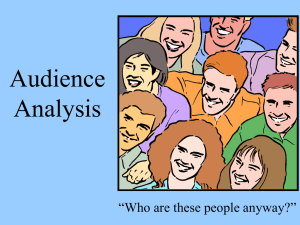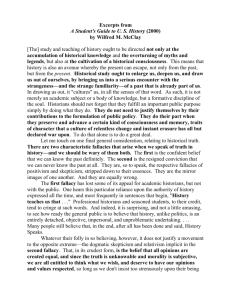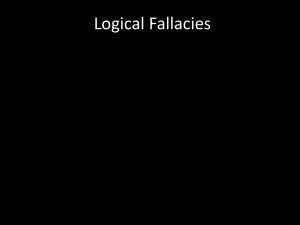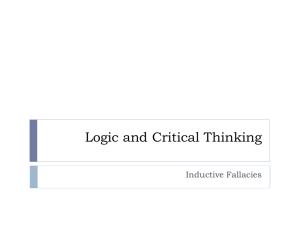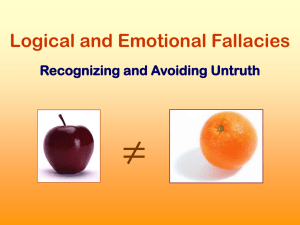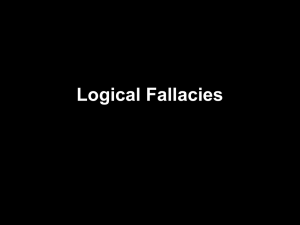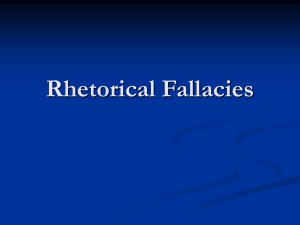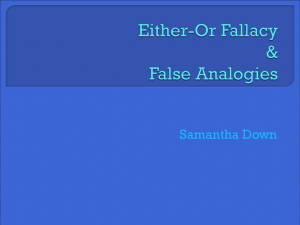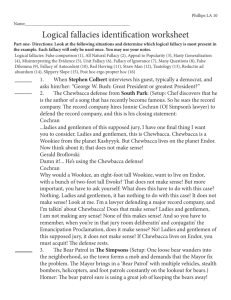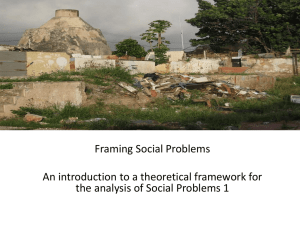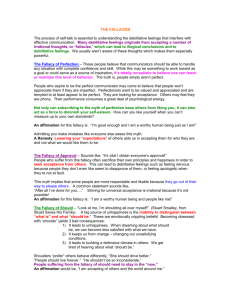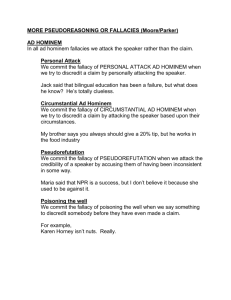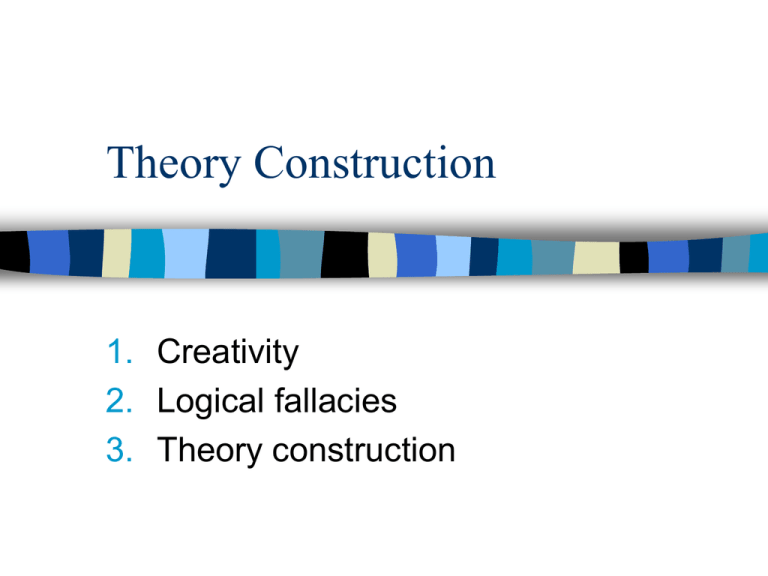
Theory Construction
1. Creativity
2. Logical fallacies
3. Theory construction
Science is a creative enterprise
• Looking at some old data in a new way
• To see things in a different light = to see
things at a more meaningful, theoretical
level
• To be creative, means to do something
new, to have a different thought about
the way things work
Example
• For a long time offenders and victims were
believed to be two distinct groups of
individuals
• Data from the UCR and NCVS indicate that,
like their offenders, victims of serious violent
crimes are disproportionably male, African
American, young, single, (i.e., never married,
separated, or divorced), and have low
socioeconomic status.
New view at victims
• The same individuals tend to be both victims and
offenders
• Offenders are also likely to be more attractive
targets for crime because they can be victimized
with little chance of legal consequences
• They are reluctant to report victimization because
they do not want to attract attention of the police to
their own illegal activities because they are more
likely to become victims of crime while committing
other felonies
• “Offender-victims” are less likely to call the police
because they are lacking trust to the police
VanGundy (1992)
• Our major problem is in our own
assumptions about what is and is not
permissible
• Typically these assumptions serve well,
but when it comes to research or trying
to be creative, they get in the way
• Thinking outside the box
Example (VanGundy, 1992)
• “A car is parked on a straight road
facing west. A man gets into the car and
begins driving. After traveling for a
while, he finds that he is east of this
starting point. How can this be?”
Solution(s)
• Most people assume that he man will
drive forward
• He could just easily have put car in
reverse and backed away
• He may have made a U-turn and struck
out for the sunrise
• Also, he might have just driven around
the world
Consider the figure below
• How many squares does it contain?
Solution
•
•
•
•
Sixteen small squares
One large outer square
Four 3 x 3 squares
Nine 2 x 2 squares
Answer
• “Once in a while”
The “nine dots” puzzle
• The challenge is to
connect the dots by
drawing four straight,
continuous lines, and
never lifting the pencil
from the paper.
Solution
• The puzzle is easily
solved, but only if you
draw the lines outside of
the confines of the
square area defined by
the nine dots themselves.
Thus, the phrase
"thinking outside the box"
was born
In-the-box thinkers
• In-the-box thinkers are skillful at killing
ideas
• They are masters of the creativity killer
attitude such as "that'll never work" or
"it's too risky"
In-the-box thinkers
• They also believe that every problem
needs only one solution; therefore,
finding more than one possible solution
is a waste of time
• They often say, "There is no time for
creative solutions. We just need THE
solution."
Outside the Box
Thinking outside the box requires different
attributes that include:
• Willingness to take new perspectives
• Openness to do different things and to do
things differently.
• Focusing on finding new ideas and acting on
them.
• Listening to others.
• Supporting and respecting others when they
come up with new ideas
Sources of Ideas
• Curiosity about things is the source of
all research
• Curiosity alone may be too diffuse; it
needs to be given focus and direction
• Look for evidence on the validity of
explanation
Example
• A. Brill, a Freud’s colleague, developed
a hypothesis that ….”what appears to
be telepathic communication between
two people in the same setting may be
explained by their simultaneously
seeing someone in the environment that
independently triggers the same thought
in each.” (Freud, 1938)
Observation
• The necessity for careful observation can
hardly be overemphasized particularly when
dealing with human behavior
• We ignore whole chunks of the behavior
around us
• Well-trained habits of observations can be
more important in research that a great store
of academic knowledge
Anecdote (Beveridge, 1957)
• A Manchester physician, while teaching a
ward class of students took a sample of
diabetic urine and dipped a finger in it to taste
it. He then asked all the students to repeat his
action. This they reluctantly did, making
grimace, but agreeing that it tasted sweet. “I
did this,” said the physician,…” to teach you
the importance of observing detail. If you had
watched me carefully you would have noticed
that I put my first finger in the urine but I
licked my second finger”.
Obstacle to accurate observation
• People see and remember only what
they expect to see
• Have you developed an expectation that
no matter which line you get in at the
bank (or grocery checkout), it will be
the slowest-moving line?
Optical illusions
• Reinforce the point that we may be
mistaken about what we think we see.
Optical illusions
ab=bc
Optical illusions
The tops of the two
boxes are identical
in size and shape
The three cylinders are all
of the same size
Observation and inference
• There are many other kinds of
observation errors
• They may lead to errors of reasoning
Common logical errors
•
•
•
•
Hasty generalization
Appeal to Unreliable Authority
Selective observation
Fallacies of the wrong level
1. Ecological fallacy
2.
Reductionism
• Spuriousness
Hasty generalization
• Generalization from a single (or a few)
observation
• “There is no drug problem in our school.
I have talked to 30 students from my
class and none of them use drugs”
Hasty Generalization?
•
Bill: "You know, those feminists all hate men."
Joe: "Really?"
Bill: "Yeah. I was in my philosophy class the other day and that Rachel
chick gave a presentation."
Joe: "Which Rachel?"
Bill: "You know her. She's the one that runs that feminist group over at
the Women's Center. She said that men are all sexist pigs. I asked her
why she believed this and she said that her last few boyfriends were
real sexist pigs. "
Joe: "That doesn't sound like a good reason to believe that all of us are
pigs."
Bill: "She said that she had seen enough of men to know we are all
pigs. She obviously hates all men.“ Joe: "So you think all feminists are
like her?"
Bill: "Sure. They all hate men."
Sound statement?
• “I hate those little dogs. We had a
miniature poodle when I was growing
up. All “little snookums” did was whine
and throw up.”
Appeal to unreliable authority
• This fallacy occurs when the source cited as a reason
to believe a claim is either
• not actually a reliable authority,
• a reliable authority on some subjects, but not the one in
question, or
• is asserting a claim that is quite controversial even among
reliable authorities in the field
Appeal to unreliable authority
• “My boyfriend says I can’t get pregnant
if I sneeze after having sex”
• “Dr. X is a Nobel Prize winning
physicist, and he says that drinking
lemonade can cure cancer”
• “I read in the National Enquirer that
actress Jamie Lee Curtis is really a
man”
Selective Observation
• Also called cherry picking, the enumeration of
favorable circumstances (or counting the hits
and forgetting the misses)
• For example, a state boasts of the Presidents
it has produced, but is silent about its serial
killers.
• Or, the claim "Technology brings happiness".
(Now, there's something with hits and
misses.)
Fallacies of the wrong level
• Ecological fallacy
• Reductionism
Ecological fallacy
• Inferences made about individuals
based on information about groups
are not to be trusted
Example
• “The university of Chicago produces the
finest scholars in the country. John, who
received his PhD from the University of
Chicago, must be one of the finest
scholar in the country”
Example of ecological fallacy
• For example, a researcher might examine the
aggregate data on income for a neighborhood
of a city, and discoverer that the average
household income for the residents of that
area is $30,000.
• The ecological fallacy can occur when the
researcher then states, based on this data,
that people living in the area earn about
$30,000
Ecological fallacy (two housing
estates)
Sound statement or ecological
fallacy?
• Observational studies have found that
countries with greater coffee
consumption has lower number of heart
disease
• So, everyone who drinks more coffee
will have lower chance of developing
heart disease
Statement is wrong
• This is wrong because there could be other plausible
explanations.
• Maybe the countries with great coffee consumption only
have a small portion of individuals drink coffee but they
drink in ridiculously large volume
• And the other portion (the non-coffee drinking groups)
which exercise regularly and consume healthy disease
and this is this latter group (not the coffee drinking
group) contribute to lower risk of heart disease
Reductionism
• Inference about groups based on
information about individuals are not to be
trusted
Example
• Each musician in Hometown Symphony is the
best there is.
• Conclusion: The Hometown Symphony is
the best there is
• The majority of people in country X cherish
democratic ideals
• Conclusion: Country X is a democratic
society
Sound statement?
• Every ingredient in this drink tastes
great. Therefore, this drink will taste
great.
• Ingredients: chili with cheese and
onions, chocolate cake, bananas,
lemonade.
Spuriousness
• Spurious relationship - a relationship
that appears to exist at face value, but
that disappears when you control for
another variable
Spurious relationship
What is Theory?
• Theory is a set on interconnected
statements of propositions that explain
how two or more events or factors are
related to one another
Direction of theorizing
• Two logical systems-two ways to
construst a theory
• Deductive logic-(hypothesis,
observations, empirical generalizations,
theory)
• Inductive logic (observations, empirical
generalizations, theory)
Quantitative and Qualitative
• Hypothesis
•
• Data are in the form of
•
numbers from precise
measurement
•
• Theory is largely causal
•
and deductive
•
• Replication is possible
• Analysis proceeds by using
statistics, tables, or charts
No hypothesis
Data are in the form of words and
images from documents,
observations, and transcripts
Theory noncausal and inductive
Replication is rare
Analysis proceeds by extracting
themes or generalizations (although
numbers are possible)
Two ways to construct a theory
Induction
THEORY
Deduction
FINDINGS
HYPOTHESIS
Analysis
Operationalization
DATA
GATHERING
RESEARCH
DESIGN
Measurement

